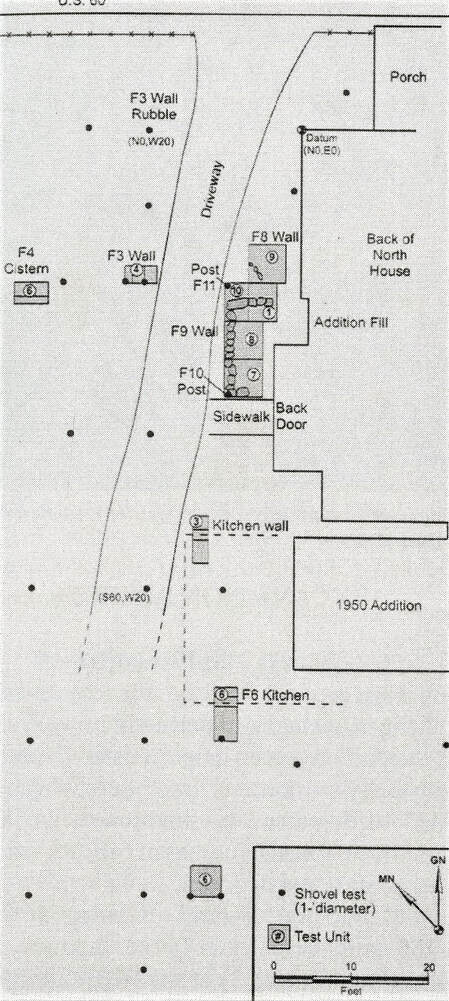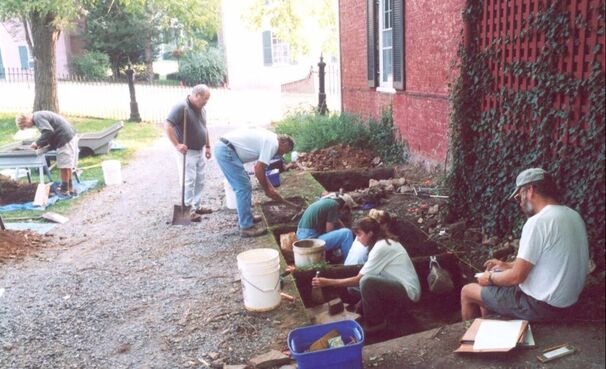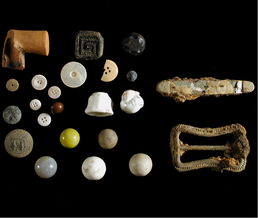As the Greenbrier Historical Society celebrated the 200th birthday of the North House in 2020, we reflected on its history and the people who inhabited the house we now call home. This exhibit explores the people that lived in the house, the changes to the house, and the role of enslaved people in its early history.
Early History
Henry B. Hunter purchased the property in 1818 and had the house built in 1820. The NH 200 exhibit is displayed in one of the three original bedrooms in our two-story brick ell-shaped house. It is believed John Dunn built the home, but there is no historic evidence that supports this claim. The original house had a detached kitchen, housing for the enslaved people, and a garden.
The North Family Residence
1821 - 1836
John North and Charlotte Blain were married on July 15, 1819. They moved into the newly constructed house in 1821 with their young daughter Margaret and had four more daughters while living there: Mary, Martha Jane, Isabelle, and Charlotte. They lived in the house for fifteen years until 1836 when they moved into a newly constructed brick house across town. While living in the house, John North owned at least three enslaved people, likely more. By 1850 John held twelve people in slavery. The enslaved people performed domestic chores such as cooking, nursing children, and driving the carriage.
John A. North
December 15, 1794 - September 26, 1857
John was born in Staunton, Virginia and served in the War of 1812. Following the war, he was appointed clerk of the Greenbrier District Court of Chancery and moved to Lewisburg. Later, he was appointed clerk of the Virginia Supreme Court of Appeals, organized in Lewisburg in 1831. In the 1830s he helped to establish the Blue Sulphur Springs Resort and oversaw its construction and the hiring of enslaved labor. John inherited enslaved people, purchased them, and gave them as wedding presents to his daughters. John was described as having a delicate constitution and frame, never weighing over 130 pounds. He was well-respected in the community and people trusted his legal advice.
“Your uncle North is not expected until Wednesday; do you not think a Trumpet should be blown the old Lady [North], mourns his absence, almost like a young bride.”
-Mary Lewis
Charlotte Blain North
April 23, 1800 - April 22, 1883
Charlotte was born in Lexington, Virginia and met John while visiting an aunt in Lewisburg. John quickly started courting Charlotte and even persuade her to move up their wedding date. Charlotte was known for her ability as a manipulator and her strong nature and was often called “the queen,” “her Highness,” and “the aristocracy.” After her daughter Mary’s death, Charlotte opposed her widowed son-in-law, Thomas Hamner’s, remarriage to his close friend, Maria Horton. Charlotte did everything in her power to prevent the match because of the swiftness of the relationship and Maria’s lower social status.
The North Daughters
Margaret North JohnstonMay 16, 1820 - June 3, 1851
Margaret was the oldest daughter of John and Charlotte North. She married Robert Johnston in 1845 and moved to Richmond, Virginia where Robert worked as an auditor. Margaret died at the age of thirty from cholera. |
Mary North Hamner
|
Isabelle Abney North CaldwellJune 21, 1824 - May 7, 1897
Isabelle was the third daughter of John and Charlotte North. She married James R. Caldwell in 1852 and lived in a brick house on the banks of the Greenbrier River, now called Elmhurst. They had six children, but only three survived into adulthood. Isabelle suffered many illnesses in life and died from complications related to an old leg injury. |
Martha Jane North DennisJuly 7, 1828 - Sept. 27, 1895
Martha Jane was the fourth daughter of John and Charlotte North. She attended the Lewisburg Academy and continued her schooling in Flushing, New York. She married Robert F. Dennis in 1849 who was the prosecuting attorney for Pocahontas, Greenbrier, and Fayette Counties. They did not have any children. |
Remembering Those Individuals Enslaved by John North
Charles, John, Lewis, Mima, Sam, Milly, Laura, Maria, an unnamed black boy, Mary and her children — Pompy, Ellen, and Rachel — and Rachel's children Frederick and Horace, and those whose names are lost to history
Mary
Unknown Birth and Death Dates
|
Mary was enslaved by the North family and worked as the cook in their detached kitchen. Mary had three children, Rachel, Ellen, and Pompy. When Mary became pregnant, Charlotte wrote in 1847, “Mary was confined two weeks to her room…I and John and two greener hands never were put in to a kitchen…I had to go to Mary for every direction how and when to cook.” Pompy was not mentioned again and likely died or was sold. Rachel stayed with the Norths and was not mentioned after John’s death. Ellen was given to Mary North upon her marriage and moved with Mary’s husband, Thomas Hamner, to Pittsylvania County, Virginia.
|
In 1847, Charlotte wrote to John, “You ask how I found all the Darkys when I got home they were on the (increase) in numbers and poore Mary feeling bad enough...but poore Mary is sick that is a bother although John dose right well- I have just give him up to the kitchen business.”
In 1847, Isabelle North wrote, “Pompy is beautiful but will not come in the house- but stais in the kitchen and gets up in Marys lap when ever he can. I made John pick him up yesterday and bring him to me.”
|
Sam
Unknown Birth and Death Dates
Sam was the family’s coachman who was often mentioned in letters sent between family members. As a coachman, he was trusted by the family to take notes and passengers to their destinations.
Ellen
Unknown Birth and Death Dates
Ellen was be caught in-between the fight between Charlotte and Thomas and his second wife Maria. Charlotte's brother-in-law Johnson Reynolds wrote, “The Norths can’t bear the idea of Mr. Hamner taking off Ellen the girl, given to Mary Hamner. They want Mr. North to purchase her…The old man…told him he would give Mr. Hamner a negro man for her. On Mr. Hamner’s return…not one of the aristocracy made any inquiry whatever after Maria. This mortified Mr. Hamner very much. And Mr. Hamner says that he has been informed that Mrs. North said they would give $2000 for Ellen, before that Slut [Maria], should ever be mistress over her”.
"The court is held here, where parties make frequent excursions to hear a speech at the bar, dine at Frazier's and then return in the evening".
The Star Hotel
1836 - 1854
James Frazer purchased the North House in 1836 and more than doubled its size adding rooms for guests and various outbuildings. An 1854 description of the property stated there were two good cellars, an orchard, a vegetable garden, a fifty-horse stable, outhouses comprising of servants’ (enslaved) cabins, kitchens, a meat house, and a dairy. James also built the Greenbrier County Court Library on the adjacent property in 1834. The Hotel was popular among judges and lawyers who could do their research next door at the library. The hotel was also a stagecoach stop for springs resort travelers. Locals gathered at the Star Hotel for dinner and even singing. Historic accounts praised the quality of dinner served at the Star Hotel, even President Martin Van Buren, “sat down to a scrumptious dinner, prepared for the occasion by our worthy and esteemed James Frazer.”
James A. Frazer
July 7, 1783 - February 11, 1854
James was born in Spotsylvania County, Virginia and later moved to Greenbrier County. He married Elizabeth Frazer (his cousin) and they had eight children. He bought a tavern in downtown Lewisburg in 1823 on Washington and Lafayette Streets before he bought the Star Hotel in 1836. He was known locally as the “polished old hotel-keeper who figured so prominently in the early history of Lewisburg.” James managed the Star Hotel from 1836 till his death in 1854. He used enslaved labor to maintain the large hotel and grounds. The number of enslaved people increased throughout his life and at his death he owned twenty-five people.
Remembering Those Individuals Enslaved by James Frazer
Friday Strother, Willis Lewis, Little Willis, Anne, Jon, Mima, Malinda and her son Jon, Letty, Warner, Moses, Molly and her children — Dick, Nancy, and Milly — Julia and her children — John, Charlott, and Adam — Matilda, old Molly, Amanda and her child —Virginia, Rob, Bill, and Mason — Dinah, Molly, and those whose names are lost to history
In 1814, after Elizabeth Frazer's father died, he left seven enslaved people, Nelly and children Beverly, Clarissa, Sarah, Anne, Matilda, and young Nelly, to his three daughters. Elizabeth received at least two enslaved people.
Friday Strother |
Willis Lewis |
c. 1817 - March 3, 1882 |
c. 1787 - 1816 - March 15, 1888 |
|
Friday worked as an enslaved house servant in the Star Hotel. Friday participated in the Civil War when he “went with his owner at his bidding, in the capacity of servant.” Following the Civil War, Friday took the last name Strother and married his wife Julia. They had two sons named James and John. Friday worked with one of his sons at the Lewisburg Hotel as a waiter. Friday also had a passion for gardening, winning several awards. When the railroad was completed in 1873, he moved to Charleston, West Virginia. Friday was a democrat, which at the time opposed civil and political rights for African Americans. Why he aligned with those political views is unknown.
|
Willis was enslaved by James Frazer and was freed between 1855 and 1857. Willis moved to Ohio as freed people were required to leave the state. In October 1857, Willis petitioned the Greenbrier County Court to become re-enslaved. His reasons are unknown, but the combination of fear, economic uncertainty, and a longing for his family and community might have led him back to slavery in Virginia. After the Civil War, Willis married Rosa Perkins, the matriarch of the Perkins family who enjoyed entrepreneurial success in Lewisburg. Willis and Rosa had two children named Willis and Charlotte.
|
Willis and Friday served as witnesses in a trial against another man, Lewis, enslaved by Ballard Smith. Lewis, who was accused of stealing a gold watch, was cleared of all charges.
Ann |
Moses |
Unknown Birth and Death Dates |
c. 1833 - Unknown Death Date |
|
Luke Bowyer sold Ann to James Frazer for $434.31 in 1817.
|
Moses was bought by James Frazer on June 4, 1841 from Sampson Mathews for $385 at the age of eight, separated from his mother Lucy.
|
The Frazer Family Residence
1854 - 1871
After the death of James Frazer, his son James Frazer II inherited the Star Hotel. With no desire to continue operating the hotel, James II tried to sell the house with no success. The hotel was turned into a private residence where James II and his family lived. Their granddaughter recalled the house as “having four or five big rooms in the long ell of the house that were always tightly locked and were never used…a long passage or hall ran by all the doors and first one of the row was open and used by all of us as a play room.” After James II’s death, his wife Sophia and their daughter Martha continued living in the house. James II’s estranged sister Sarah and her family lived in the apartment in the back of the house. The siblings fought over their fathers’ estate. Sophia and Sarah also did not get along, but fortunately, the house was so large they "seldom met and never entirely amicably.”
James Frazer II
July 6, 1812 - March 27, 1860
James II attended the Lewisburg Academy and later moved to St. Louis for business where he met his wife, Sophia Foulke. Together they had six children. James was described in his granddaughters memoir as, “a man, years older than his wife and a rather hard, domineering, Scotch, and though he adored Sophia, he ruled her completely.” He died of complications related to alcoholism which likely contributed to his dominant personality and debt. James II owed nearly $700 (equivalent to $20,000 today) at his death.
Sophia Foulke Frazer
1817 - February 23, 1885

Sophia married James Frazer II before 1839 in St. Louis, Missouri and moved back to Lewisburg with him. Sophia was described by her granddaughter, Mary Taylor Randolph as “a tall, commanding, figure, regular features and large piercing brown eyes…her hair was abundant and snow white…[she was] emotional, yielding and rather frivolous.” Sophia lived in the house for eleven years after her husband’s death. She sold the house in 1871 and moved to St. Louis to live with family.
The Harris Family Residence
1871 - 1905
Joel McPherson and his wife Amanda purchased the house from Sophia Frazer in 1871 for their daughter Rebecca and her husband, John Harris. John Harris modernized the house by removing the larger hotel addition, various outbuildings, and adding a wooden kitchen to the back of the house. He also added Victorian details such as metal window hoods, new windows, and segmented columns.
John Harris
December 5, 1840 - December 7, 1910

John was born into a merchant family in Albemarle County, Virginia and attended Dickinson College and the University of Virginia. John served for a year in the Confederate Army and reached the rank of major before returning home in bad health. He became a lawyer in 1862. John married Rebecca McPherson on January 30, 1866. They had six children together. John enjoyed a lucrative law practice in Lewisburg, but his political career never took off due to his cold manner. Rebecca died in 1887 and John married Catherine Eudora Mason Tate in 1889.
Harris Travel Letter from LondonJuly 7, 1878“our voyage out was exceptionably rough and disagreeable. Rain and fog, rough seas and head winds, prevailed nearly throughout and it was not until towards the close of our ninth day…that the sun appeared. It was certainly hailed with delight and I shall never wonder, hereafter, that many people have been worshippers of the sun. In fact, I am thoroughly disenchanted of the sea.”
|
President's Home
1905 - 1972
Robert Telford was the first president to live in the North House but not the last. The house was remodeled by architect, Stanhope Johnson, in 1925. This addition included the port-cochere and two-story southern sunroom. The wooden kitchen added by Harris was removed and new floors, fireplaces, hardware, and windows were added. Functions were held for the students and faculty in the building. There is evidence that at least four presidents lived in the home including Robert Telford, John Armstrong, French Thompson, and Ralph Murray. In 1954, President John F. Montgomery had the house converted into faculty housing.
Robert L. Telford
1863 - March 28, 1934

Robert was born in Georgia and attended the Union Theological Seminary in Richmond, Virginia. Following his graduation in 1890, he was appointed pastor of the Old Stone Presbyterian Church in Lewisburg. That same year he married Anne Boone Brown and they had ten children. Robert served as pastor until he became the president of the Lewisburg Female Institute (Greenbrier College for Women). Robert was the first president of the school to live in the North House. He purchased the home in 1905 and sold it to the school in 1915 for future presidents. Robert was described as, “a truly Christian gentleman, always sympathetic and understanding, a lover of music, friendly and friend-winning, and generous to a fault.”
French W. Thompson
April 16, 1876 - April 25, 1961
Helen Holt |
Yvette Prevost Yarid |
West Virginia State Department of Mental Health
1973 - 1975
In 1973, Greenbrier College was sold to the West Virginia State Department of Mental Health. On January 24, 1975, Senate Bill No. 199 was introduced to transfer the North House to the Greenbrier County Commission. The county in turn leased the building to the Greenbrier Historical Society. However, the deed did not include the transfer of the house's contents and numerous antiques were taken to Charleston to decorate state offices. Because of the uproar, Governor Moore promised that any relics not needed by the state would be returned.
Greenbrier Historical Society
1975 - Present
The Greenbrier Historical Society was established in 1963 and previously rented a building on Austin Street in Lewisburg. The North House Museum opened its doors to the public on July 4, 1976. The Wagon House was built in 1992 to store the Isaac Coffman Virginia Valley Covered Wagon. On June 29, 1994, the North House was officially purchased from Greenbrier County. In 2000, the board approved plans for an addition to the building that provided room for the archive, library, collections storage, gift shop, and staff offices. Today, the Greenbrier Historical Society uses the North House to preserve and share the diverse history and culture of the Greenbrier Valley through exhibits and educational programs.
North House Archaeology Excavation
2001
Dr. Kim and Stephen McBride led an archaeological survey of the North House. The dig was organized as a class at the Greenbrier Community College and was open to volunteers. Ten test pits were dug around the property and revealed several stone foundations and numerous artifacts.






























